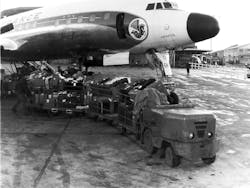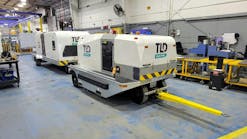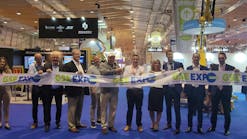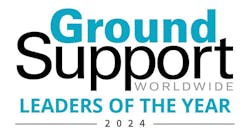Our magazine may be barely into its first generation, but look how far the commercial industry went in only two generations. Just 50 years after the Wright Brothers’ first flight, the British Overseas Airways Corp. was operating the first passenger jet service.
And consider how much the industry changed in little more than the following two generations:
In 1958, for example, more people crossed the Atlantic by ship than plane. In the United States, the 10 largest transportation companies were all railroads. Less than one in 10 Americans had ever even been on an airplane. The notion of “how far” it was from New York to Los Angeles was measured in days. Hawaii drew just 171,000 visitors.
With that in mind, here are some milestones in GSE development:
1705 – The Goldhofer family starts a forge in Amending, Germany.
1811 – Friedrich Krupp starts casting steel, which he uses to produce tanner’s tools and coin blanks.
1860 – What eventually will become the TLD Group begins with a silk-weaving business in Lyon, France.
1883 – John Bean invents a continuous spray pump to battle bugs on his 10-acre almond orchard. Neighboring growers clamor for the new-fangled device and the Bean Spray Pump Co. is born.
Not many years later, Earl Estes starts the Dixie Manufacturing Co. The company’s original product line includes horse collars and saddles. You may have heard of John Bean, but what about Earl Estes? We’ll pick up both their stories in 70-some years
1891 – Brothers August and Joseph Thyssen start out with a coalmine and steelworks
1902 – Wilbur Wright becomes the world’s first ramp agent. This year marks 110 years since Orville Wright took off from the sand at Kill Devil Hills aboard the Wright Flyer into a freezing headwind of 27 miles per hour and flew about 35 yards.
Take a look at one of history's most famous photos, and you can plainly see Wilbur on the ground offering support to the Wright Flyer on its maiden voyage. It’s not too hard to imagine that Wilbur may have a wrench or two in his pockets on that cold day as he runs along the sand as the plane takes flight.
A closer look, however, reveals the picture also shows a work bench and a jumble of something to the left of the bench.
That turns out to be world’s first “GPU.” We found out more about the details at an EAA Web site on vintage aircraft:
“On the right end of the airplane’s foot-printed outline is a small footstool or bench, with a large C-clamp lying across the center support of the bench,” H.G. Frautschy writes. “Ken Hyde of the Wright Experience believes they used the clamp to gently secure the wingtip of the machine to the bench, to prevent the Flyer from rocking too much from side to side in the breezy conditions as they prepared it for flight.
“To the bench’s right, there is the starting battery, with its kinky, stiff wire sticking out of the wooden box. It was used to start the engine of the Flyer, which was also equipped with a Splitdorf dynamo. A battery was needed to supply enough electricity to generate a spark within the primitive make-or-break ignition system used for the engine. There’s also a shovel and a small can, which, according to "The Papers of Wilbur and Orville Wright" edited by Marvin W. McFarland, contained “nails, tacks and a hammer in it, for emergency repairs.”
1914 – The “aeroplane” is just starting to see military service at the start of World War I. Over the next four years, the planes graduate from reconnaissance missions to bombing runs. The Hucks starter, an auxiliary power unit that provides the initial start-up power to piston engines, proves that machines replacing workers isn’t anything new. It’s also the first glimpse of the debt GSE owes to the agricultural industry since many of the machines were used directly or served as the creative springboard for equipment such as belt loaders and deicing sprayers.
The Hucks Starter, named after Bentfield Hucks, a captain in the Royal Flying Corps, transmits power to the aircraft by way of a power take-off shaft, found on agricultural machines. The shaft of the starter fit into a special protruding hub incorporates a simple projecting claw clutch on the center of the airplane's propeller assembly. When engaged, the power of the truck’s engine is transmitted to the aircraft engine until start up, whereupon the faster speed of the now-running engine disengages the clutch, and then the starter truck clears the area prior to takeoff.
(There’s a picture of a Hucks Starter in Tony Vasko’s column on page 24.)
1917 – C.C. Hobart, along with his wife, Lou Ella, and their three sons, Edward, Charles and William, start what will become Hobart Brothers. The company gets it start making generators, metal office furniture and air compressors. Within 10 years, it becomes a powerhouse in the welding industry, but the company's entry into GSE has to wait another four decades.
1918 – Pilots buzz small town America as barnstorming proves to be a popular form of entertainment.
All a daredevil pilot needs is an open field to land on, in other words, the first farm he spots. After cutting a deal with the farmer, the pilot performs various stunts for the crowd. Many of history’s best-known aviators, such as Charles Lindberg and Amelia Earhart, got their starts on the barnstorming circuit.
Meanwhile, the farmer could lend an extra hand with his tractor. Which, of course, is why even to this day, we refer to an aviation towing vehicle as a “tractor.”
Farm tractors prove a reliable source for aircraft towing throughout most the early days of aviation.
1923 – Clark Tructractor Co., better known today as forklift manufacturer, Clark Material Handling Co., builds the Duat two tractor to pull trailer load of lumber, freight and industrial material. This workhorse looks like very much like a today’s tugs.
1926 – Dan Mikesell starts the American Brattice Cloth Corp. begins selling its flame-proof cloth cut to order for the mining industry. Some 60 years later, ABC Industries is known for ducting materials and other GSE products.
Godtfred Vestergaard starts his business at his home outside Copenhagen, Denmark. The company’s original product was aluminum molds for constructing mattresses. Later, the company starts making lifts for a university near Copenhagen. Also, the company manufacturs a piano lifting device for a music academy, a stage platform for a theater and attractions at the Tivoli Garden.
1928 – Two years after founding Kato Engineering, owners Elmer Jensen and Louis Wilkinson hire Cecil Jones who develops a rotary converter that lets rural families operate AC appliances with DC storage batteries.
1929 – Regent Manufacturing sets up show. It will go on to sell product to almost every domestic and international aircraft and aerospace program since World War II.
1933- J.C. Gorman and H.E. Rupp, two engineers out of work during the Great Depression, begin making pumps in a barn outside of Mansfield, OH. Their competitors ridicule their first line of “non-clogging” pumps. The company goes on to report $359 million in sales for 2011.
1935 – E.P. “Ed” Grime starts the Malabar Machine Co. as a machine shop for making items from customer drawings. Grime proves to have a keen eye. In just a few years, Lockheed asks Grime to build the first tripod jacks specifically for aircraft.
1938 - Kato receives its first government contract to furnish the original 31 U.S. Army flying fields with AC generators for ground instrumentation needed for aircraft to land.
1939-1945 - Aviation has an enormous impact on the course of World War II and the war has just as significant an impact on aviation. The United States has 3,600 military aircraft when Hitler marches into Poland in 1939. By the end of the war, U.S. military aircraft production reaches nearly 300,000 – turning out more than 96,000 aircraft at peak production in 1944.
Of course, the whole world is arming itself. As a result of all this aircraft, we finally begin to see a real market for GSE or as the U.S. military refers to it to this day as the “forgotten enabler.”
We start recognizing more names of well-known manufacturers:
The Northwestern Motor Company – the “NMC” of NMC-Wollard – introduces a two tractor.
During the war, Stewart & Stevenson builds hundred of tractors and self-propelled bomb ordnance loaders for the air force.
Hobart Brothers produces 100,000 welders and 45,000 generators to support the war receiving the Army/Navy E Award for its efforts.
Columbus Jack of Columbus, OH, gets its start selling most of its production to the military fighting World War II (and later the Korean War).
Ford, as just an example of other automotive makers, takes its 9N tractor and adds cast-iron plate around the front and rear, and more than a half-ton of weight over the front and rear. Axles. Approximately 10,000 of these tractors dubbed Moto-Tugs see duty, many on aircraft carriers.
The David Clark Co. provides one of the more interesting stories in the aviation industry at this point. Started as company that makes griddles and bras, the company begins specialzing in air force and NASA protective equipment ranging from anti-G suits to space suits.
1945-1959 – Commercial aviation starts to take off as military aircraft, in particular jets, are converted to commercial aircraft. By this time, a host of international GSE manufacturers are well on their way to build specialized equipment to meet the needs of commercial aviation:
Hobart Brothers sets up Hobart Ground Power after American Airlines asks the company to design a generator to start larger aircraft engines.
Wilt and Violet Paulson start the Willamette Aircraft and Engine Co., which performs aircraft maintenance and converts military training aircraft to civilian use. The company becomes better known later as Lektro.
Air-A-Plane begins manufacturing PCA units.
Jorg Schopf, a mechanical engineer, founds Schopf, which starts out building equipment for the mining industry.
Davis Taylor builds an electric-powered cart for his own use in his poultry supply business. After numerous requests for other area ranchers, he starts the Taylor Shop. Fred Dunn joins Davis Taylor’s business in 1951, and several years later the company changes its name to Taylor-Dunn Manufacturing Co.
The Mulatier et Dupont company becomes TissmEtal Lionel-Dupont and later the TEIEflex Lioneil-Dupont. At this time the diversified manufacturer is in several markets, including the “aeronautical” sector.
Garsite, LLC starts manufacturing aircraft refuelers, hydrant dispensers, fuel delivery trucks, above-ground fuel storage tanks, aviation fueling systems and vacuum pumper trucks.
TracMa begins making tractors designed for aircraft towing to replace the farm tractors commonly used at the time. The name of the company becomes synonymous with “tractor” in French-speaking countries in the same way “tug” is used in the United States.
ACE starts business making test equipment for the aviation industry, but also expands into GSE.
An airport manager and a friend of Axel Ackerman, who started AXA Power Apes in 1924, asks Axel to make a small 28V DC rectifier for starting small aircraft. The unit AXA delivers works without problems until 1995.
Lektro produces the first electric golf cart at a time when most courses don’t allow carts. Two years later, the company creates it first battery-driven vehicle to feed mink. Afterward, the electric mink feeder gets modified and the result is an electric chicken feeder.
Joe Cochrane creates Cochrane Equipment to build the first belt loaders specifically for the aviation industry. The company eventually expands into cargo loaders and, after an ownership change, becomes known as Lantis Corp.
L.W. (Lu) Taylor and Harold Higbee start Enfab Inc. Innovative engineering led to the to the creation of a proprietary fiberglass filter coalescer. The company is eventually renamed Velcon Filters.
Albret gets its start making maintenance platforms and aircraft docking systems. Later, the company adds passenger stairs
Jim Kaplan starts Harlan Corp. to rent and rebuild lift trucks. A former marine pilot, Kaplan owned an eggshell processing plant and, later, rebuilt generator plants. Kaplan soon realized that parts to commonly fail in lift trucks were not readily available. He redesigned the parts and developed sources for new designs. Ten years later, one of his customers in Venezuela asks Kaplan to make tow tractors. Harlan buys a Model E Clark lift and re-engineers it. Eventually, the company grows from building 10 tractors a month to 90 tractors a month.
Stewart & Stevenson enters the GSE business with GM Detroit Diesel. During the decade, designed and built approximately 1000 low silhouette, self-propelled GPUs with a 400 Hz, 90 kava generator set for major airlines.
Remember Dixie Manufacturing that got its start selling to the horse and buggy market in the 1880s? At this point, the company takes one of its canvas "nose bags" - in other words, a horse feeder - and turns that into a tool bucket for the utility industry.
Undoubtedly, the 1950s closed on a high note for GSE. Depending on date, the first passenger bridge in the United States was installed at San Francisco International Airport and also at LaGuardia Airport in 1959.
1960 – SCHOPF broadens its scope, designing and manufacturing its first aircraft tow tractors based on what the company learned from developing loaders for the mining industry. GOLDHOFER
Remember John Bean? By this time, the company is known as FMC Corporation (“Food Machinery Corp.”) with $1 billion in sales. Engineers start building some of the first deicer vehicles that used aerial devices to spray aircraft. Its early deicers could deice a plane in 15 minutes. FMC also develops a cargo handling system for the new containerized generation of jet aircraft. The self-propelled Flite-Line Loader allows one person to unload a plane’s full cargo of containerized baggage in just 15 minutes.
S.L. Parker opens a metal fabricating business called Parker Industries making garbage containers under the trade name “Par-Kan.” GSE waits for another 30 years before the familiar brand name is put on baggage carts and other GSE.
Clyde W. Olson starts Clyde Machines Inc. and begins making hydraulic motors for tampers used by utility companies. Full production of GSE begins shortly thereafter.
1962 – Richard Stern and Yves Helleboid form Devtec to distribute and service GSE outside of the United States. Much later, Devtec becomes TLD Asia and TLD America.
1963 - U.S. Airmotive GSE begins provide a full line of GSE parts and supplies for the industry.
1966 – Bud Bushnell buys the manufacturing rights to a material lift operated on compressed air. Customers are impressed with the “magic in the bottle” and Genie Industries gets its name.
Vestergaard is approached by SAS and asked to modify some existing aircraft deicers. As a result, Vestergaard was given the order for new aircraft deicers. The “Beanstalk” as they are informally called, consisted of a vertical, telescopic tower with a platform on top from which the operator applied fluid with a spray gun.
1967 – Lektro produces a small electric aircraft tug using a chassis originally built for an eclectic cart to feed mink. The tug was built for an FBO in Oregon.
1968 – Robert Watkins starts General Transervice Inc., an airport refueler maintenance company at PHL. GTI goes on to develop the Rampmaster, a modular design that simplifies maintenance by separating the truck from the fuel tank.
1969 – Eagle Tugs introduces its bobtail cargo tractor, a model still in production.
John L. Grove forms a partnership with two friends and buys a small metal fabrication business in McConnellsburg, PA. The company sells its first JLG aerial lift. Many of the design features in that first lift are still being incorporated into products today.
1970 – Robert Smith buys Estex from the founder’s widow. Smith, having grown up near the Atlanta Airport, figures the company’s product line could expand into the aviation industry. Products include baggage cart side curtains.
The Dana Corp.’s flight department starts Danair. It first products were towbars for corporate jets. Danair is sold in 1980 and becomes Tronair.
1972 – ITW Military GSE begins specializing in military GSE.
Paul MacCready, an avid aviator who set soaring records in his glider in the 1940s, starts AeroVironment Inc. The company becomes a leader in unmanned aircraft and eventually well-known for electric GSE charging stations.
MacCready also makes the history books again in 1977 when the Gossamer Condor, becomes the first heavier-than-air craft powered solely by the pilot’s muscles. Later, the Gossamer Albatross flew across the English Channel.
SAGE Parts opens to distribute parts and service throughout the world for the GSE industry.
Trilectron begins manufacturing GSE.
1973 – TUG Manufacturing Corp. is founded. Core business begins with production of baggage tractors, primarily the Model MA, which is still produced today. TELL story of tug at Museum. Tug eventually expands its product line and introduces its Model 660 belt loader. In 1998, Stewart & Stevenson buys the company and becomes known as S&S TUG. The combination of TUG and S&S' airport division provides the GSE industry its broadest product line. S&S TUG then merges with Davco Industries, a specialist in regional airline equipment broadening the line further.
After an ownership change in 2005, TUG's name is changed to TUG Technologies Corp.
In September 2009, TUG donated a restored Tug Serial No. 001 to the Musuem of Commercial Aviation, Forest Park, GA. The company's first tractor was delviered to Epps Airport Service at Peachtree-DeKalb Airport on Oct. 8, 1973. Realizing the importance of keeping this part of its history, TUG bought the tractor from Key On Ground Services in Clearwater, FL.
1975 – David Clark Co. introduces the first headset specifically designed to provide hearing protection for pilots providing clear, isolated reception and transmission at normal voice levels inside noisy aircraft.
1976 – Nicky Ghaemmaghami establishes Hydraulics International, which goes on to specialzes in miltary GSE.
1979 - Jim Watkins starts WASP, Inc. (Watkins Aircraft Support Products) in Alexandria, MN, specializing in non-motorized GSE. In a news article, Watkins says, "Our first year of business we had just one customer, now we have 10. And we just got our first government order. We feel we can provide a lots of jobs and bring other investment money into our community." In 1980, sales were $280,000. One year later, sales topped a million. Jim's also right about the jobs - six employees have each worked at WASP for 30 years. Watkins end up building another plant in Nebraska. By 1996, sales grew to $33 million and Jim sells the company to his employees in 1997.
1980s – TracMa and Air France introduce the first towbarless tractor.
1981 – Vestergaard starts building a new type of deicer, the Elephant Alfa, equipped with the now familiar telescopic spray boom. The Elephant MY and Elephant Beta and the Elephant BETA-15 will follow.
1984 – Lektro redesigns the “Airporter”
1987 – FCX Systems, Inc., starts to design and manufacture solid-state frequency converters.
ERMA get its start selling GSE to Airbus.
After decades of manufacturing heavy equipment for construction and transportation industry, Goldhofer introduces a towbarless tractor for the GSE market.
1987 – Matt Sheehan starts AERO Specialties, a manufacturer and distributor of new and used GSE throughout the world.
1989 – Jamie Kaplan joins Harlan Corp. as president. Jamie develops the company’s low profile tractor that remains the company’s highest-volume product.
1990s – George Prill starts GSE Today in 1992.
Jim and Jamie Kaplan hire George Revere to help improve Harlan Corp.’s business operations and market strategies. Since the late-1990s the company has expanded its product line into the electric GSE market
TLD creates its GSE division and acquires TracMa, Albret Industrie, Erma, Devtec (in the United States and in Asia) and Lantis. By the end of the decade, TLD decides to specialize in GSE and sells its aeronautical equipment division.
A.T. Juniper’s commercial engine wash system originated from the military wash rigs Juniper designed in the 1980s. The rigs were first trialed commercially in the early 1990s at Gatwick Airport with Virgin Atlantic using shepherd’s hook type washing probes directing the washing solution into the booster from positions behind the fan.
Stephen Parker, expands Par-Kan into GSE and other equipment for the aircraft industry. In a reverse from tradition, here’s one GSE industry that then goes into the agricultural industry with a grain weigher.
Patrick G. O’Brien starts MCM Engineering Inc. O'Brien was the Chief Engineer for well-known GSE companies such as Hobart Brother, Devtec (now TLD) and McCormick-Morgan before starting MCM.
Premier Engineering & Manufacturing Inc. enters the deicing arena initially servicing the line of deicers that Premier's founder Jerry Derusha helped build out of engineering school. Shortly after starting, Premier builds its own line of deicers and receives a contract for 64 units from United Airlines.
Alan J. Janis and Bruce K. Wayne open J&B Aviation Aviation Services Inc. The company initially capitalizes on its design for 400 Hz cable assemby, but expands extensively in other other GSE, inclucing PCA, baggage chutes and air-starts.
The Northwestern Motor Co. buys Wollard Airport Equipment Co.’s broad line of GSE. In 2000, the company becomes known as NMC-Wollard.
FMC buys Jetway Systems the original creator of apron drive passenger boarding bridges, and the world’s leading manufacturer of boarding bridges, solid state 400Hz inverters and fixed PCAir. FMC also bolsters its airport equipment division with the acquistion of Trump deicers.
Metroplex Conveyor & Services begins fabricating and installing safety/maintenance and production platforms, and modifying and servicing machinery for the bakery and food industry as well as luggage conveyor systems inside airports. As a result of this laste relationship, Metroplex develops a PCA hose trolley system that continues to be a large part of the company's business.
Lektro introduces two new electric vehicles, one for the military and the other for commercial aviation, that represents one of its main lines today.
Air T buys the Simon Deicer division from Terex and subsequently renames the company Global Ground Support LLC.
The first hybrid-electric two tractor was tested at the North Island Naval Air Station in Coronado, CA. The ISE Research ThunderVolt hybrid tractor used an Entwistle Co. MB-4 tow tractor chassis, and is the first of three such tractors to be placed into service with the United States Air Force and United States Navy in 1999.
1999 – Two German steel companies merge to form ThyssenKrupp.
2000 – Illinois Tool Works creates the ITW GSE Ground Services division, which brings together Hobart Ground Power, AXA Power, Trilectron Industries and Air-a-Plane, and, finally, J&B Aviation.
2001 – Cygnus Business Media buys GSE Today and renames it Ground Support and later Ground Support Worldwide.
FMC Airport Systems re-enters the military market with the design and development of the Halvorsen loader, selected by the USAF to replace all its existing 25K cargo loaders.
006 – ColumbusJACK acquires Regent Manufacturing.
2008 – John Bean Technologies Corporation (JBT Corporation) is formed, and becomes a publicly listed company on the New York Stock exchange.
2009 - Velcon founder Lu Taylor’s son, Dave, and grandson, Chase, sell company and launch Petroleum Equipment Aviation Refueling.
2012 – Lektro delivers its 3,700 towbarless tractor tractor to DTW.






